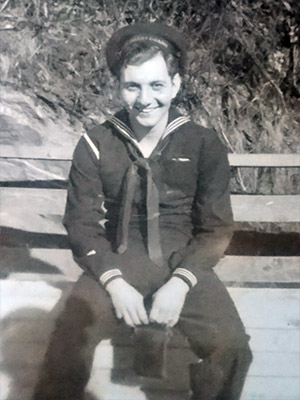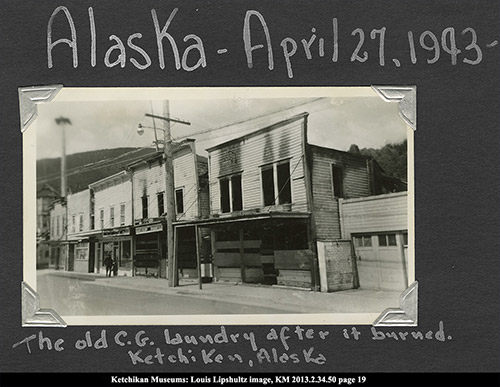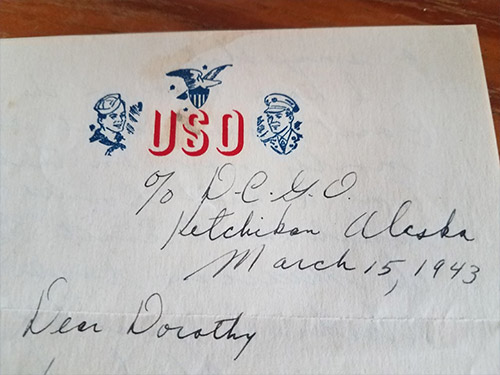Tragic laundry fire killed three during WWIICoast Guardsmen were staying in building that had been taken from Japanese interneeBy DAVE KIFFER June 24, 2019
But not all the deaths in the war took place in combat. One of the largest losses of life in Ketchikan during World War II took place in a laundry near the intersection of Mission and Stedman streets.
Three Coast Guardsmen, part of the large number of servicemen in the community during the war, died in the early morning hours. They were Kenneth L. Pifer, apprentice seaman, Leonard N. Olsson, apprentice seaman, and Pempillo Villanueva, officers steward. They were living in a dormitory the Coast Guard had requisitioned because there wasn't enough on-base housing during the War. The building had been the Young American Laundry prior to the war. The fire broke out in the early morning hours on April 8, 1943, according to the Ketchikan Chronicle. "The flames made such headway by the time they were discovered that those arriving on the scene had little hope for saving the adjoining buildings," the Chronicle reported in its afternoon edition later in the day. "The Rev. James Hall in the adjacent Presbyterian Church Building turned in the alarm at 3:40 am this morning when he was aroused by the shouts of those in the burning building." The Chronicle noted that 40 people were living in the three buildings at the time. "Six of the men living over the laundry, their only other avenue of escape cut off, jumped from the rear windows to the creek bed below, flooded by high tide," the newspaper reported. "Four of the men swam to the other side and the two others came to the beach on the side under the flaming buildings. Flames and sparks shot high into the air illuminating the sky and reflecting on buildings blocks away." The Chronicle reported that officials believed the fire started on the ground floor of the building in a "drying room." "It may have a short circuit or boiler explosion," 'the newspaper reported. "One of the victims is believed to have sacrificed his life attempting to warn others of the fire as he was dashing through the building awakening fellow service men when he was last seen alive." The Chronicle reported that, in addition to the three fatalities, three servicemen were severely injured in the blaze, two suffering burns and one suffering smoke inhalation. Meanwhile the building next to the laundry was also destroyed by the fire and two other buildings, including the Presbyterian Church were significantly damaged. The building where the fire broke out had been renovated by the Coast Guard several months previously. "The former Japanese-operated laundry was remodeled after it was taken over by the Coast Guard last October," the Chronicle noted. "New modern laundry equipment was installed on the ground floor and the second floor was completely refurbished with a kitchen, mess hall and barracks with accomodations for 28 men."
The paper also reported that Coast Guard officials said the building had been completely rewired during the renovation. The Chronicle reported that several occupants of the adjacent building barely escaped with their lives after being awakened by the servicemen fleeing the burning laundry building. The second story of that building was occupied by the High Lead Rooms operated by Goldie Crabtree and it had the Close Furniture Store on the street level. The occupants of the High Lead crawled through a window into the Shasta Rooms next door which were above the Deluxe Café. Both the laundry building and the High Lead building were destroyed by the flames and were torn down and replaced by other buildings. Eventually the Alaska Loggers Association building would be built on the site. Both buildings were owned by George Suzuki, a Ketchikan resident of Japanese descent who was interned in a relocation camp in Minidoka, Idaho. The Chronicle reported that the buildings were only insured for a total of $3,000. On April 9th, the Chronicle reported that the three servicemen were to be buried in Bayview Cemetery and that is where the story takes on an interesting twist. In 1979, Diane Wilkins, a cousin of one of the men, Kenneth Pifer, visited Ketchikan on a cruise ship and went to Bayview Cemetery to see the gravesite. She said a cemetery worker showed her the site and the headstone with the three men's names on it. She took a picture, but no longer has it. In 2018, she decided to research the fire, after her mother came across some letters that Pifer had written the family from Ketchikan three weeks before the fire. "After the war, a pal of Kenny, who served with him in Ketchikan, wrote her that he barely escaped the fire, thanks to Kenny pushing him out (of the building)," Wilkins wrote in in an email last year. "When mom tried to write him back, her letters were returned. That letter is missing and she no longer remembers his name." Wilkins says that the letters themselves contain mostly info about Pifer's service buddies and his life in California. "He wrote that because of censorship he was unable to give any details about exactly where he was in Alaska and what he was doing." Wilkins wrote in 2018. "Think that there was great paranoia about Japan invading Alaska at the time, hence the secrecy." Wilkins says that Pifer was from Santa Monica and was in the Coast Guard Reserve during the war. He was 21 and an only child in his family. Wilkins has a copy of Pifer's death certificate which indeed notes that he died because of "burns from conflagration" in Ketchikan on April 8, 1943 and was buried in Bayview Cemetery. The Coast Guard officer who signed off on the certificate was Ensign Wm K. Boardman, who stayed on in Ketchikan after the war and eventually became a State Legislator and served as the Speaker of the Alaska House of Representatives.
But, according to City of Ketchikan records, there is no Kenneth Pifer at Bayview, nor is there a Leonard Olsson or a Pempillo Villanueva. Officials at the Ketchikan Coast Guard base have no records of the fire or the deaths. The Federal registry of service members who died in World War II does not list three men either. And the local veterans groups that are responsible for placing flags at each veteran's grave for Memorial Day have no recollection of ever seeing a grave site for three Coast Guardsmen from 1943. Several walks of likely locations for the grave site at Bayview have also turned up no signs of the three men's grave and the current cemetery sexton says he has never seen it. But there are the newspaper stories, and the letters, and the death certificate. And it is likely that somewhere in the expanse of Bayview Cemetery, there is the final resting place of three men who came to Alaska to help in the fight against Imperial Japan and have remained here ever since.
On the Web:
Contact Dave at dave@sitnews.us Dave Kiffer ©2019 Publication fee required. © Representations of fact and opinions in comments posted are solely those of the individual posters and do not represent the opinions of Sitnews.
|
||||||





